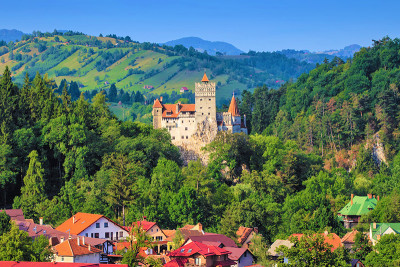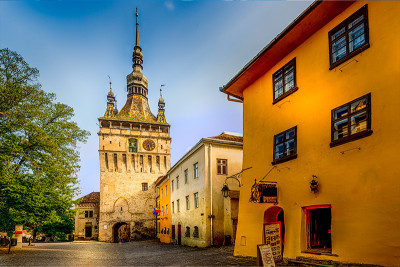Great Union Day is a national holiday in Romania. This is the celebration of the unification of Transylvania, Bessarabia, and Bukovina with the Romanian Kingdom. This happened on December 1, 1918. The country celebrates with free concerts and parades in every city, along with traditional dishes. It is a day of celebration and parties, with TV specials on air and fireworks at night.
Even though Romania was not officially unified until 1918, this is a long process in the making. The first attempt at Romanian unification is accredited to the Wallachian Voivode, Michael the Brave. He tried to unify most of what is modern-day Romania around the years 1599 to 1601.
However, this attempt was forcibly abandoned when Michael was assassinated under the orders of the Holy Roman Emperor Rudolf II. The Emperor did not want Michael to have so much control. Michael briefly had power over Wallachia, Moldova and Transylvania, but with his death the union of these three lands ended.
Romania was under Austro-Hungarian rule for many years and could not see a way out, or a way for them to unify themselves and escape control from others. As a result, the Romanians tried to push for autonomy within the Empire but did not have much success. For instance, during the 1848 revolutions, the peasant forces of Avram Iancu in Transylvania were a major obstacle for the Hungarian army to secure Transylvania.
The peasant forces’ efforts definitely slowed the Magyar’s war for independence against Austria, but did not lead to Romanian autonomy. The Austrians did not want to encourage the peasant forces and resorted to the Russians to help them silence this rebellion.
Later, in 1859 under the leadership of Alexandru Ioan Cuza, political union was created between Wallachia and Moldova. Actually, a couple of years before in 1856, the Treaty of Paris that ended the Crimean War forbade Wallachia and Moldova from joining together. So, instead of declaring union, Wallachia and Moldova elected the same man to the throne: Alexandru Ioan Cuza.
Cuza did many great things for the new unified Romania. He introduced agrarian reform with the eradication of serfdom. This, however, turned out to be his downfall. Landowners, the wealthy, and conservatives did not like these reforms and decided to oust Cuza in 1866. Tensions had also been growing because of a scandal due to his relations with a mistress: Maria Catargiu-Obrenovic. With his ousting, the people invited in their new king: King Carol I.
King Carol I kept the unified Wallachia and Moldova together, which was not an easy feat. It was with his reign that the country began to be known as Romania, and in 1866 the Romanian Constitution was signed, sealing this country together. Romania was able to obtain full independence from the Ottoman Empire by aligning with the Russian Empire, who were enemies of the Ottomans.
The Russians were able to defeat the Ottomans, and the Russians demanded Romanian independence – but there was a catch for the Romanians. The Russians gave Romania Northern Dobruja, but wanted to keep Southern Bassarabia. The Romanians consented, and this allowed Carol I to be declared as first King of this new Kingdom.
King Carol I was of German heritage and worked to align himself with Germany leading up to the first World War, even though this was not the leaning of the people. When King Carol I died, his son Ferdinand reigned, alongside his Queen Marie who was British. The pair decided to align the country with the Triple Entente (Russia, France and Britain), which better represented the leanings of the public. The timing of this switch was not great, to say the least, because the Russian army was failing and suddenly Romania found itself surrounded by the enemy, with no hope for help from allies.
Ferdinand then signed the Treaty of Focsani on December 9, 1917, which was an armistice agreement that ended hostilities between Romania and the Central Powers (Germany, Austria-Hungary, the Ottoman Empire, and Bulgaria). Marie believed this treaty to be perilous and vehemently opposed to signing of the Treaty of Bucharest, which was a peace treaty between Romania and the Central Powers in May 1918.
Ferdinand refused to sign the treaty and so the Prime Minister, Alexandru Marghiloman, signed it instead. The war was finally officially over with the Armistice with Germany, signed November 11, 1918.
On December 1, 1918 the National Assembly of Romanians of Transylvania and Hungary, which had 1,228 elected representatives, decreed by unanimous vote “the unification of those Romanians of all the territories inhabited by them with Romania.” On December 11, King Ferdinand signed this into law, decreeing that “The lands named in the resolution of the Alba-Iulia National Assembly of the 18th of November 1918 are and remain forever united with the Kingdom of Romania.”
Because Queen Marie and King Ferdinand were against the Treaty of Bucharest, they earned themselves a prominent role in the Paris Peace Conference in 1919. Marie led many of the negotiations herself, setting aside other Romanian officials, much to the shock of many of the other world leaders in attendance.
As a result of the conference, there was international recognition of Greater Romania, officially doubling the size of the country and increasing the population by 10 million.
Unification Day was first recognized as a national holiday on August 18, 1949, and it was celebrated on August 23rd. On August 1, 1990 the day was moved to celebration on December 1st.
At the first celebration of the Great Unification Day, the largest festivities were seen in Alba Iulia, where the proclamation of the union of Transylvania with Romania was signed. Today, there are celebrations throughout the entire country.
Every year there is a military parade of the Romanian Armed Forces either in Constitution Square or near the Arch of Triumph. If you ever have the chance to be in Romania for this wonderful celebration, we would highly recommend joining in on the action!

 ES
ES
 IT
IT
 DE
DE
 FR
FR


